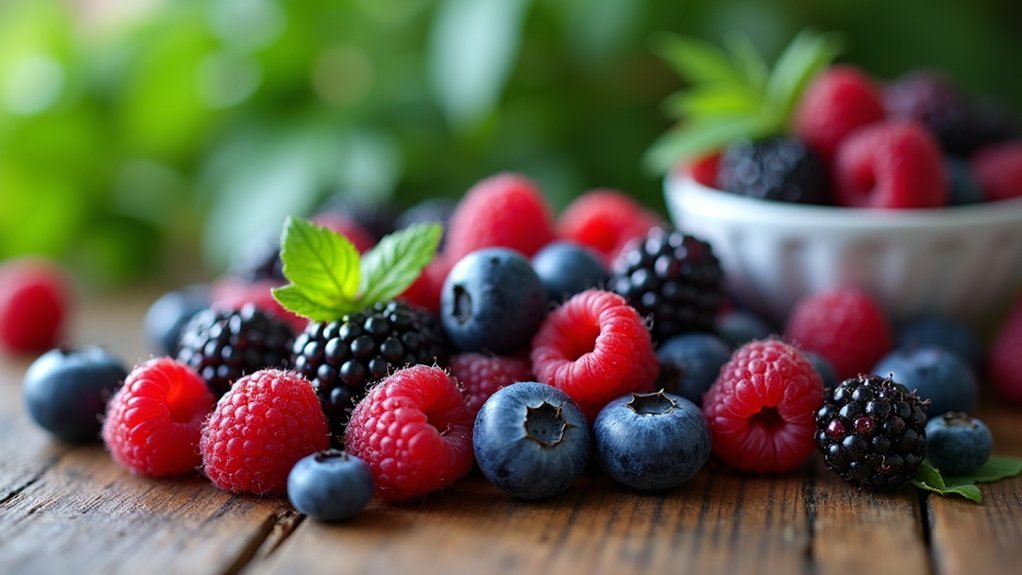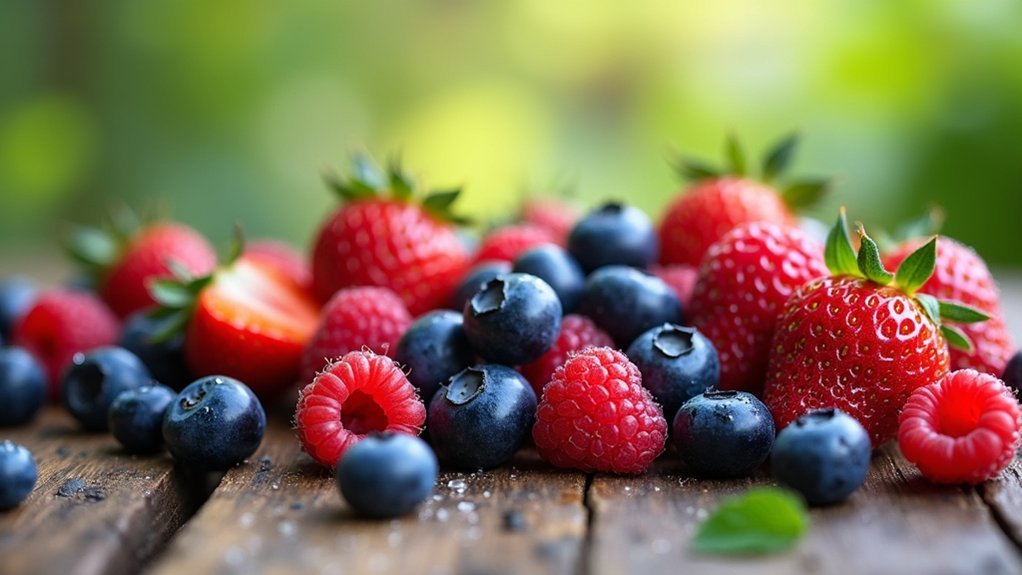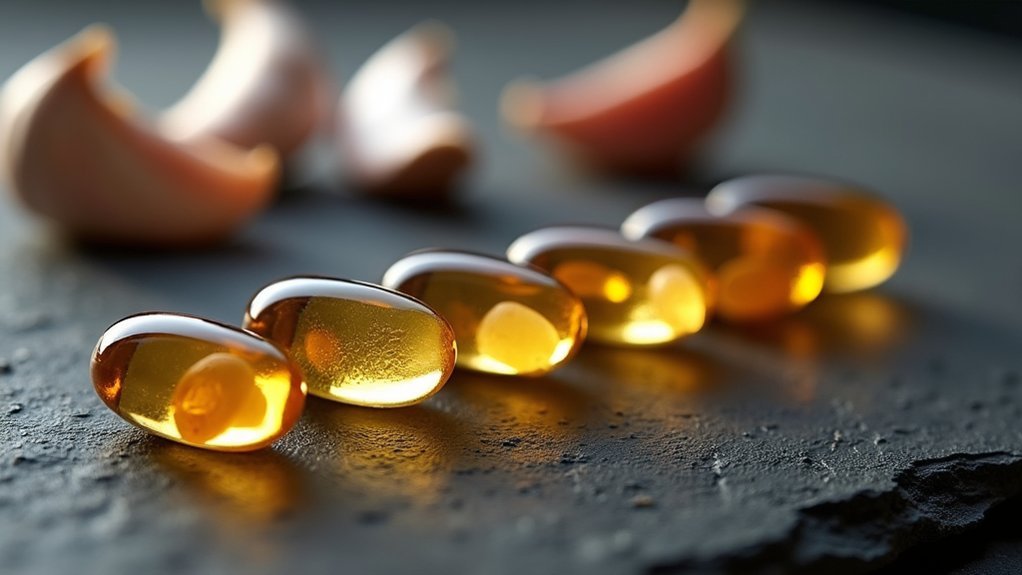Blueberries top the list for fighting cellular damage with their anthocyanins that cross your blood-brain barrier and neutralize free radicals throughout your body. Black raspberries deliver powerful chemopreventive compounds like ellagic acid that target cancer pathways, while strawberries pack 58.8mg of vitamin C per 100 grams for immediate antioxidant protection. These berries’ phytochemicals work synergistically to protect your DNA, proteins, and cell membranes from oxidative stress, with clinical studies revealing their remarkable cellular repair mechanisms.
How Antioxidants in Berries Protect Your Cells From Damage

When free radicals attack your cells, antioxidants in berries act as cellular bodyguards, neutralizing these harmful molecules before they can cause damage.
These protective compounds, including anthocyanins and flavonoids, work by donating electrons to unstable free radicals, preventing them from stealing electrons from your healthy cells.
Berry antioxidants sacrifice their own electrons to shield your cells from free radical damage, acting like molecular shields.
Your DNA, proteins, and lipids stay protected through this electron-donation process. Different berries provide various antioxidants like delphinidin-3-rutinoside and cyanidin-3-glucoside, each contributing to reduced oxidative stress throughout your body.
This cellular protection extends to your heart and brain, where berry antioxidants offer cardioprotective and neuroprotective benefits. Research shows that cranberries demonstrate anti-cancer mechanisms including apoptosis and necrosis against multiple cancer types.
Blueberries: The Anthocyanin Powerhouse for Cellular Defense
When you eat blueberries, you’re consuming one of nature’s most concentrated sources of anthocyanins—powerful compounds that cross your blood-brain barrier to deliver targeted cellular protection.
These anthocyanins, particularly malvidin and delphinidin types, neutralize reactive oxygen species (ROS) with remarkable efficiency, achieving some of the highest antioxidant capacity ratings among all berries.
Your cells benefit from this triple advantage: ultra-high anthocyanin density, direct brain access, and superior free radical elimination power. Research demonstrates that blueberry anthocyanins activate MAPK pathways, including ERK1/2 and p38, which enhance your body’s natural antioxidant enzyme activity at the cellular level.
Anthocyanin Concentration Level
Blueberries pack an exceptional punch when it comes to anthocyanin content, establishing them as one of nature’s most potent sources of these cellular-protective compounds. When you’re choosing berries for maximum health benefits, you’ll find blueberries consistently rank among the highest in anthocyanin concentration compared to other berry varieties.
| Anthocyanin Type | Percentage of Total |
|---|---|
| Malvidin glycosides | 47.9% |
| Delphinidin compounds | Lower concentration |
| Cyanidin forms | Lower concentration |
The dominant compounds you’ll consume are malvidin-3-glucoside and malvidin-3-galactoside, which deliver the most significant antioxidant capacity. However, you should know that anthocyanin levels can vary based on the specific blueberry variety you choose and the fruit’s ripeness when harvested. Research shows that these compounds demonstrate synergistic antioxidant effects when combined with other beneficial substances like catechin.
Blood-Brain Barrier Crossing
Beyond their impressive anthocyanin concentrations, blueberries possess a remarkable ability that sets them apart from many other antioxidant-rich foods—their compounds can cross the blood-brain barrier and deliver protection directly to your neural tissue.
Scientific studies confirm that blueberry anthocyanins reach brain tissue after consumption, with concentrations detected in regions associated with learning and memory.
Once inside your brain, these compounds neutralize free radicals, reduce oxidative stress, and support cellular defense systems. Studies show that improvements in spatial working memory can be observed within just three weeks of regular consumption.
Research demonstrates measurable improvements in cognitive performance, memory, and neuronal health with regular blueberry consumption.
While anthocyanins have low bioavailability, their ability to cross the blood-brain barrier makes blueberries uniquely positioned to provide direct neuroprotective benefits where you need them most.
ROS Neutralization Power
As reactive oxygen species (ROS) bombard your cells daily through environmental toxins, stress, and normal metabolic processes, blueberries stand as one of nature’s most powerful defenders against this cellular chaos. Their secret weapon? Anthocyanins like malvidin and glycosides that literally sacrifice hydrogen atoms to neutralize free radicals before they damage your cellular structures.
| Mechanism | Effect |
|---|---|
| Anthocyanin donation | Neutralizes free radicals directly |
| SOD enhancement | Increases cellular antioxidant capacity |
| HO-1 upregulation | Boosts protective enzyme levels |
| XO-1 inhibition | Reduces oxidative stress production |
| Lipid peroxidation block | Prevents membrane damage |
You’ll find blueberries particularly effective in protecting neuronal and endothelial cells, where they’ve demonstrated measurable ROS reduction and enhanced antioxidant defenses across multiple cellular models. Beyond neutralizing oxidative stress, anthocyanins accumulate specifically in blueberry skin where they provide concentrated antioxidant protection at the cellular level.
Black Raspberries and Their Chemopreventive Properties
You’ll find black raspberries pack a powerful punch against cellular damage through their unique chemopreventive properties that actively target cancer development pathways.
Their rich profile of anthocyanins, ellagitannins, and ellagic acid creates a formidable antioxidant defense system that’s been shown to inhibit tumors in multiple organs including the esophagus, colon, and breast.
Clinical studies reveal these dark berries don’t just prevent oxidative stress—they actively modulate inflammation, block angiogenesis, and promote apoptosis in damaged cells. Research demonstrates that black raspberry anthocyanins can restore gut microbiota balance by increasing beneficial bacteria while reducing harmful pathogenic species in the digestive system.
Cancer Prevention Mechanisms
When researchers examine black raspberries’ cancer-fighting potential, they’ve discovered remarkable chemopreventive mechanisms that target multiple pathways involved in tumor development.
You’re looking at fruit that actively suppresses cancer cell proliferation through dose- and time-dependent mechanisms, particularly in cervical cancer studies. These berries trigger apoptosis in cancer cells while simultaneously modulating your immune system’s response.
Black raspberries inhibit regulatory T-cell recruitment at tumor sites while promoting cytotoxic CD8 T-cell activity. They suppress critical oncogenic signaling pathways, including STAT3 and STAT5 phosphorylation, which are linked to inflammation-driven tumor promotion.
The synergistic action of anthocyanins, ellagitannins, and ellagic acid provides greater anticancer effects than individual compounds alone, making whole black raspberries particularly effective against head and neck, esophageal, and colon cancers. Concentrated black raspberry components have demonstrated specific efficacy in preventing oral cancer in high-risk populations like smokers.
Antioxidant Compound Profile
Behind these powerful cancer-fighting mechanisms lies an impressive arsenal of antioxidant compounds that make black raspberries stand out among all berries.
You’ll find anthocyanins as the major contributors, with cyanidin 3-rutinoside leading at 244 mg per 100g fresh weight. These berries pack ellagic acid and ellagitannins, both recognized for their chemopreventive effects and bioavailability in clinical studies.
What sets black raspberries apart is their broad spectrum of polyphenols, including flavonols, phenolic acids, and flavonoids.
You’re getting total phenolic content averaging 449 mg per 100g, while total monomeric anthocyanins reach 336 mg per 100g. The antioxidant capacity measured through DPPH assays averages 2.92 mmol TE per 100g fresh weight, providing a standardized measure of their free radical scavenging ability.
This diverse compound profile creates synergistic effects, with strong correlations between antioxidant activity and these key bioactive components working together.
Clinical Study Results
The scientific community has extensively validated black raspberries’ chemopreventive properties through rigorous clinical trials, demonstrating measurable improvements in precancerous conditions across multiple organ systems. You’ll find compelling evidence across oral, esophageal, and colon tissues showing significant therapeutic benefits.
| Cancer Site | Clinical Outcomes |
|---|---|
| Oral Cavity | Histologic regression of intraepithelial neoplasia |
| Esophagus | Increased GST-pi levels, reduced 8-isoprostane |
| Colon | Reduced FAP polyp progression |
| Molecular | Tumor suppressor gene restoration |
| Systemic | Improved cytokine profiles |
Clinical research reveals you’re getting anti-proliferative and anti-inflammatory effects that reduce cellular oxidative damage. BRB treatment modulates genes controlling RNA processing while demethylating tumor suppressor genes, reversing cancer-promoting epigenetic changes. These molecular improvements translate to phenotypic benefits including lesion regression.
Black raspberries demonstrate superior effectiveness by inhibiting key inflammatory mediators like COX-2 and iNOS that contribute to oxidative stress and cancer progression.
Strawberries and Blackberries: Vitamin C Champions for Cell Protection
Powerhouses of cellular protection, strawberries and blackberries deliver exceptional vitamin C levels that actively combat free radical damage in your body.
Strawberries pack an impressive 58.8 mg of vitamin C per 100 grams, while blackberries provide 21 mg per 100 grams. One cup of strawberries delivers nearly 98% of your daily vitamin C needs.
Here’s why these berries excel at cellular defense:
- Immediate bioavailability – Their vitamin C provides rapid antioxidant protection to neutralize harmful free radicals.
- Enhanced nutrient absorption – Vitamin C boosts iron absorption from plant foods, improving overall cellular function.
- Synergistic protection – Additional antioxidants work alongside vitamin C to maximize cellular defense against oxidative stress.
Both berries offer cholesterol-free nutrition while supporting your body’s natural repair mechanisms. Strawberries also contain ellagitannins that further reduce oxidative stress throughout your cellular systems.
Key Phytochemicals That Make Berries Effective Against Oxidative Stress

While vitamin C provides impressive cellular protection, berries’ true defensive power lies in their diverse array of specialized plant compounds called phytochemicals. These potent molecules work through multiple mechanisms to combat oxidative stress and protect your cells from damage.
| Phytochemical | Primary Sources | Key Benefits |
|---|---|---|
| Anthocyanins | Blueberries, blackberries | Neutralize free radicals, reduce inflammation |
| Ellagitannins | Raspberries, strawberries | Combat oxidative stress, anti-inflammatory effects |
| Flavonoids | Blueberries, blackcurrants | Protect erythrocytes, boost antioxidant status |
These compounds scavenge reactive oxygen species by donating electrons to free radicals. They also modulate enzyme activity, influence gene expression related to cell protection, and regulate proteins involved in metabolizing harmful substances. This multi-layered approach makes berries exceptionally effective at reducing cellular damage. Berry phenolics can also regulate nuclear receptors that control various cellular processes beyond their antioxidant capabilities.
Scientific Evidence Supporting Berries for Cellular Repair
Because berries demonstrate remarkable therapeutic potential across multiple body systems, researchers have extensively studied their cellular repair mechanisms through controlled laboratory and clinical investigations.
You’ll find compelling evidence that freeze-dried berry extracts, particularly black raspberries and strawberries, inhibit cellular transformation that leads to cancer development. Clinical studies confirm that flavanols and anthocyanins cross your blood-brain barrier, reducing oxidative stress while promoting new neuron generation.
Scientific validation spans three critical areas:
- Cancer Prevention – Berry extracts suppress malignant cell growth by interfering with molecular pathways involved in tumor initiation.
- Wound Healing – Pomegranate and grape berries accelerate tissue repair through anti-inflammatory mechanisms.
- Neuroprotection – Regular berry consumption prevents age-related cognitive decline by protecting neuronal cells from damage. Berry compounds alter inflammation pathways that affect nerve cell health and brain function.
These findings support berries’ role in extensive cellular repair.
Maximizing Cellular Benefits: Which Berries to Choose and How Much to Consume

How can you strategically select berries to maximize their cellular repair potential?
Choose blueberries for their anthocyanins and vitamin K (24% DV per cup), which support neuronal health and brain cell survival.
Black raspberries deliver ellagic acid with proven anticancer activity, while blackcurrants reduce colon cancer markers through prebiotic effects.
Strawberries provide anti-inflammatory compounds, and cranberries offer cardiovascular protection.
Consume at least two servings weekly—studies show this reduces Parkinson’s disease risk by 23%.
One cup equals a standard serving, providing key nutrients for cellular defense.
You’ll maximize bioavailability by eating whole berries with healthy fats, as processing reduces fiber content.
Combine different berry types for broader polyphenol spectrum coverage, enhancing cumulative antioxidant effects against oxidative stress.
Acai berries stand out with antioxidant content that may surpass other berries for preventing cell damage linked to diseases.
Frequently Asked Questions
Do Frozen Berries Have the Same Cellular Protection Benefits as Fresh Ones?
You’ll get nearly identical cellular protection benefits from frozen berries compared to fresh ones. Freezing preserves antioxidants and anthocyanins effectively, so you’re not sacrificing health benefits when choosing frozen options.
Can Berry Supplements Replace Whole Berries for Fighting Cellular Damage?
Berry supplements can’t fully replace whole berries for cellular protection. You’ll miss the synergistic effects of fiber, polyphenols, and other compounds that work together in whole fruits to maximize antioxidant benefits.
Are There Any Side Effects From Eating Too Many Antioxidant-Rich Berries?
You’ll experience digestive issues like stomach upset or diarrhea if you eat too many berries. You might also face allergic reactions, medication interactions, excessive sugar intake, and potential nutrient imbalances.
Do Organic Berries Provide Better Cellular Protection Than Conventionally Grown Berries?
You’ll likely get better cellular protection from organic berries since they contain higher antioxidant levels and vitamin C content. Organic strawberries particularly show superior cancer cell suppression compared to conventional ones.
How Long Does It Take to See Cellular Benefits After Eating Berries?
You’ll notice immediate antioxidant effects within hours, but they’re short-lived. For sustained cellular benefits, you need consistent berry consumption over weeks. Long-term studies show meaningful protection develops with regular intake.
In Summary
You’ll get the most cellular protection by incorporating a variety of berries into your daily routine. Focus on blueberries for their high anthocyanin content, black raspberries for cancer-fighting compounds, and strawberries or blackberries for vitamin C. Aim for one cup of mixed berries daily to maximize antioxidant benefits. Remember, you’re not just enjoying delicious fruit—you’re actively defending your cells against oxidative damage and supporting long-term cellular health.





Leave a Reply